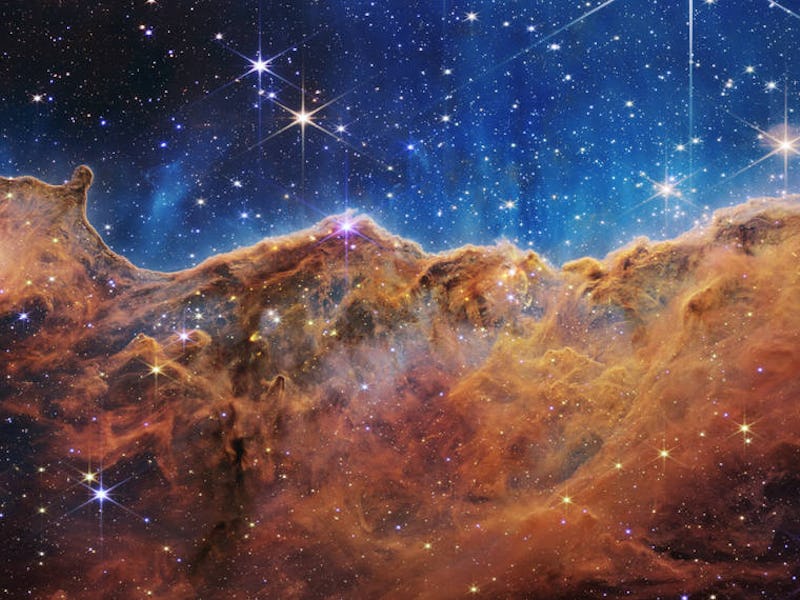Look! Webb Telescope's first 5 science images are a new era in astronomy
Welcome to the Universe.

The James Webb Space Telescope debuted its official science images Tuesday. The pictures are the hard-won prize of astronomers worldwide, who pushed through numerous delays, 33 years of conceptualization, planning, and construction; the meticulous alignment of 18 honeycomb-shaped mirrors; and a journey of a million miles into space. Officials from NASA, the European Space Agency (ESA), and the Canadian Space Agency (CSA) were eager to share the wondrous new views with the rest of the world.
On Tuesday, CSA President Lisa Campbell lauded JWST as proof of “what we can achieve when we work together,” and congratulated the “thousands of brilliant minds around the world” who make the mission possible.
These images are a view of the universe in infrared, a useful wavelength of light that can showcase the warm glow of wisps of gas and clumps of interstellar dust. The unprecedented clarity of these pictures is something only a space telescope can provide, far away from the heat of our own planet and surrounded by the cool of space that prevents distractions to their sensitive instruments.
The atmospheric composition of WASP-96 b.
Knicole Colon, an exoplanet researcher at NASA, described the first new science data on Tuesday. This wave, bending across a graph, is JWST’s first infrared spectra of an exoplanet. From this information about the world WASP-96 b, astronomers know that water vapor and clouds dwell in this Jupiter-esque planet orbiting a Sun-like star more than a thousand light years away. As Colon explained, JWST collected the starlight that illuminates the exoplanet, and scientists break this up into a rainbow. The wavelengths are “full of information,” and this is just the beginning. “A lot more to come,” she says during NASA’s announcement.
Left: The Southern Ring Nebula as seen by JWST’s Near-Infrared Camera (NIRCam). Right: The view from JWST’s Mid-Infrared Instrument (MIRI).
An audible “wow” was let out by NASA presenters when the Southern Ring Nebula image appeared, aglow in new detail. Among the remarkable features shining in this view from 2,500 light-years away are the two central stars that are now distinctly visible. JWST caught the appearance of a galaxy far behind this nebula, too, shining through the leftmost clouds and seen edge-on.
Stephan’s Quintet, seen by JWST through near- and mid-infrared wavelengths.
Then there is Stephan’s Quintet, “a cosmic dance driven by gravitational force,” according to NIRSpec instrument astronomer Giovanna Giardino. Here we are witnessing “the type of interaction that drives the evolution of galaxies,” she said during the NASA announcement. Foreground stars in the Milky Way twinkle like snowflakes around the five galaxies. The farthest four of these galaxies are almost 300 million light-years away, churning with new stars where two are merging. The image then takes us billions of light-years away, where ancient galaxies can be seen sprinkled throughout the blackness of space.
Astronomers with NIRSpec took around 1,000 images of the gas swirling around an active black hole. These data reveal a place 40 billion times the Sun’s brightness, as that gas whips around the heavy gravity of the black hole and heats to incredibly high temperatures.
The peaks and valleys of the Carina Nebula.
Then the showstopper: JWST’s view of the Carina Nebula. The texture and depth of this Milky Way object reveal stars that astronomers have never seen before. The bubbles and cavities decorate the foreground, and galaxies decorate the background.
The high-caliber instruments aboard JWST will parse through the cosmos, each unique yet capable of taking simultaneous observations. They will seek answers to astronomy’s major questions. Among them are quintessential topics that require advancing technology, like the light from the early universe. More recently, exoplanets have become a robust pursuit of astronomers, who have developed reliable methods to spot the transit of alien worlds around faraway stars, and are often able to detect what is in their atmospheres.
On Monday, President Joe Biden, Vice President Kamala Harris, and NASA Administrator Bill Nelson announced one of these images. It is a mesmerizing sight: billions of light-years deep, littered with many galaxies that are only now becoming visible to human eyes. This isn’t the farthest we’ve looked back; missions like the Cosmic Background Explorer (COBE) saw the Universe closer to the Big Bang. But pictures are singularly in a category all their own.
Webb’s First Deep Field.
Kazunori Akiyama understands the powerful reach of the visual medium, not just on scientists, but on society at large. As a Black Hole Initiative affiliate at the MIT Haystack Observatory, he collaborated on the Event Horizon Telescope, another major picture-taking project that produced the first-ever image of a black hole in 2019 and more recently, a view of the black hole at the center of the Milky Way.
“Imaging has a powerful ability to reveal the structure of the universe agnostically and unambiguously,” Akiyama tells Inverse, “and with sharper and deeper eyes, we will see, sometimes, something totally unexpected!”
Carl Sagan spoke in 1981 about a space telescope, almost a decade before the launch of the iconic Hubble Space Telescope. His words about JWST’s predecessor are relevant once again.
“The space telescope is a kind of grand intellectual adventure for all of us, which will cast light, not just on the cosmos, but also, on ourselves.”